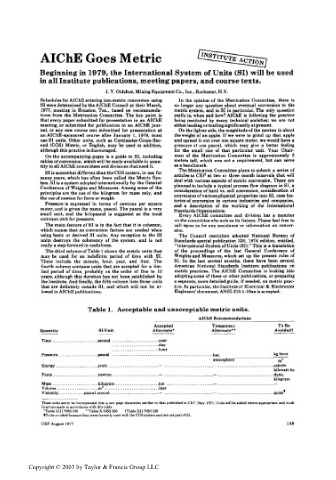Page 494 - Chemical process engineering design and economics
P. 494
AIChE Goes Metric
Beginning in 1979, the International System of Units (81) will be used
in all Institute publications, meeting papers, and course texts.
J. Y. Oldshue, Mixing Equipment Co., Inc., Rochester, N.Y.
Schedules for AIChE entering into metric conversion using In the opinion of the Metrication Committee, there is
SI were determined by the AIChE Council at their March, no longer any question about eventual conversion to the
1977, meeting in Houston, Tex., based on recommenda- metric system, and to SI in particular. The only question
tions from the Metrication Committee. The key point is really is, when and how? AIChE is following the practice
that every paper submitted for presentation in an AIChE being instituted by many technical societies; we are not
meeting, or submitted for publication in an AIChE jour- either leading or trailing significantly at present.
nal, or any new course text submitted for presentation at On the lighter side, the magnitude of the newton is about
an AIChE-sponsored course after January 1, 1979, must the weight of an apple. If we were to grind up that apple
use SI units. Other units, such as Centimeter-Gram-Sec- and spread it out over one square meter, we would have a
ond (CGS) Metric, or English, may be used in addition, pressure of one pascal, which may give a better feeling
although this practice is discouraged. for the small size of that particular unit. Your Chair-
On the accompanying pages is a guide to SI, including man of the Metrication Committee is approximately 2
tables of conversion, which will be made available in quan- meters tall, which was not a requirement, but can serve
tity to all AIChE committees and divisions that need it. as a benchmark.
SI is somewhat different than the CGS system, in use for The Metrication Committee plans to submit a series of
many years, which has often been called the Metric Sys- articles to CEP at two or three month intervals that will
tem. SI is a system adopted internationally by the General deal with various aspects of metric conversion. These are
Conference of Weights and Measures. Among some of the planned to include a typical process flow diagram in SI, a of
consideration of hard vs. soft conversion, consideration
principles are the use of the kilogram for mass only, and
case his-
the use of newton for force or weight. conversion of various physical properties into SI, companies,
various industries and
tories of conversion
in
Pressure is expressed in terms of newtons per square and a description of the working of the International
meter, and is given the name, pascal. The pascal is a very Standards Organizations.
small unit, and the kilopascal is suggested as the most Every AIChE committee and division has a member
common unit for pressure. on the committee who acts as its liaison. Please feel free to
The main feature of SI is in the fact that it is coherent, call upon us for any assistance or information on conver-
which means that no conversion factors are needed when sion.
using basic or derived SI units. Any exception to the SI The Council resolution adopted National Bureau of
unite destroys the coherency of the system, and is not Standards special publication 330, 1974 edition, entitled,
really a step forward in usefulness. "International System of Units (SI)." This is a translation
the third column of Table 1 shows the metric units that of the proceedings of the last General Conference of
may be used for an indefinite period of time with SI. Weights and Measures, which set up the present rules of
These include the minute, hour, year, and liter. The SI. In the last several months, there have been several
fourth column contains units that are accepted for a lim- American National Standards Institute publications on
ited period of time, probably on the order of five to 10 metric practices. The AIChE Committee is looking into
years, although this duration has not been established by adopting some of these or other publications, or preparing
the Institute. And finally, the fifth column lists those units a separate, more detailed guide, if needed, on metric prac-
that are definitely outside SI, and which will not be al- tice. In particular, the Institute of Electrical & Electronics
lowed in AIChE publications. Engineers' document, ANSI-210.1-19xx is accepted.
Table 1. Acceptable and unacceptable metric units.
AIChE Recommendations
Accepted Temporary To Be
Quantity SI Unit Alternate* Alternate** Avoided!
Time ..... ................second ..........................year
..........................day
..........................hour
Pressure......................pascal ................................ ..bar, kg force
atmosphere''
Energy .......................joule .......................-....—--.........................-.................-............ .calorie
kilowatt-hr.
Force .........................newton.. ..................— ...........................— .............................. .dyne,
kilogram
Mass .........................kilogram ........................ton ..........................— ...............................—
gram
a
Volume...................... ,m ............................. -liter
Viscosity..............pascal-second...........................— ...........................— .............................. .poise*
These unit* are to be incorporated into a one page document similar to that published in CEP, May. 1971. Units will be added where appropriate and modi-
fications made in accordance with this table.
•Table VUINRS330 "Table X NBS 330 tTableXII NBS 330
f To be avoided because they were formerly used with the CGS system and are not part of SI.
CEP August 1977 135
Copyright © 2003 by Taylor & Francis Group LLC

